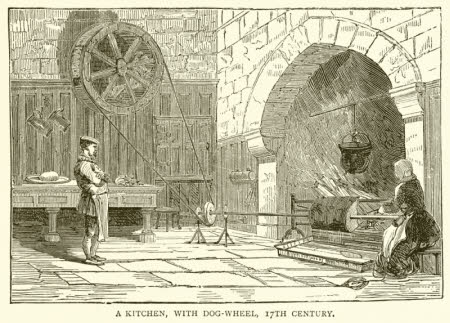Dog wheel
Category
Historic Services / Food & drink preparation
Date
circa 1600 - circa 1699
Materials
wood
Order this imageCollection
Lacock, Wiltshire
NT 149377
Caption
This 17th-century wooden wheel, set into the chimney breast of an open fireplace at a pub in Lacock in Wiltshire, is a reminder of the curious use of canine labour in historic food preparation. Prior to the advent of mechanised spits, the process of roasting meat was a laborious process. In order to be evenly cooked, meat had to be regularly rotated on a metal spit, a process which required hours of constant attention. Originally, such spits were turned manually by low-ranking kitchen servants. Eventually, however, they were powered by a breed of short-legged dogs known as turnspits. The turnspit was bred specifically to run inside wheels which were mounted on a wall near an open range, like this example at the George Inn. The wheel was attached to a chain, which ran down to the spit. As the dog ran, the spit turned, cooking the meat evenly. Wheels like this became indispensable items of kitchen machinery, not only in households wealthy enough to have the means to roast a large joint of meat on a regular basis, but also in inns and taverns. But by the middle of the 19th century, with the introduction of inexpensive spit-turning machines called clock jacks, these wheels became redundant. So too did the turnspit dog; the breed is now extinct.
Summary
Wooden dog wheel in the George Inn. The spit was powered by specially bred dogs, known as turnspits, which ran inside the wheel. Wheels like this were commonplace in kitchens prior to the 19th century.

